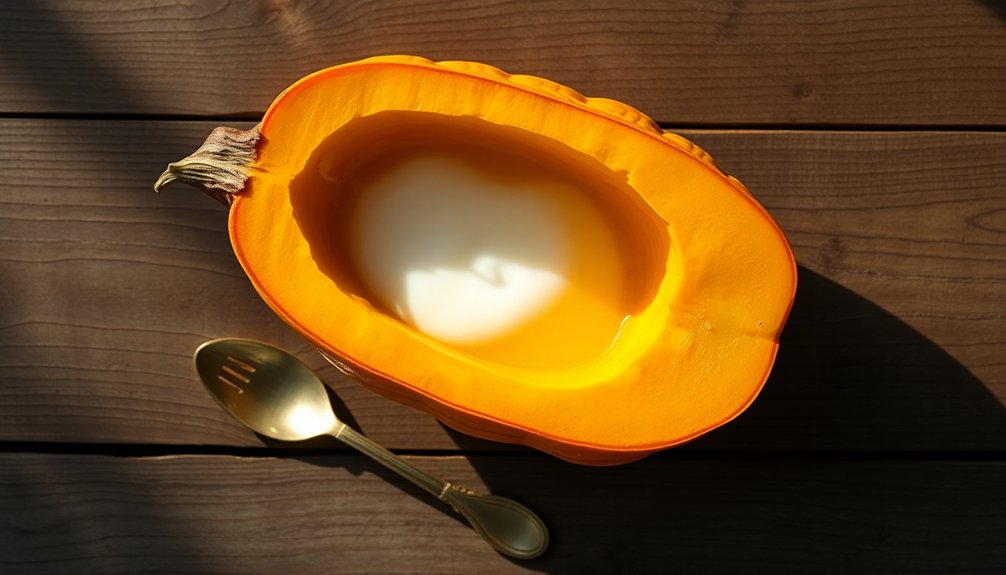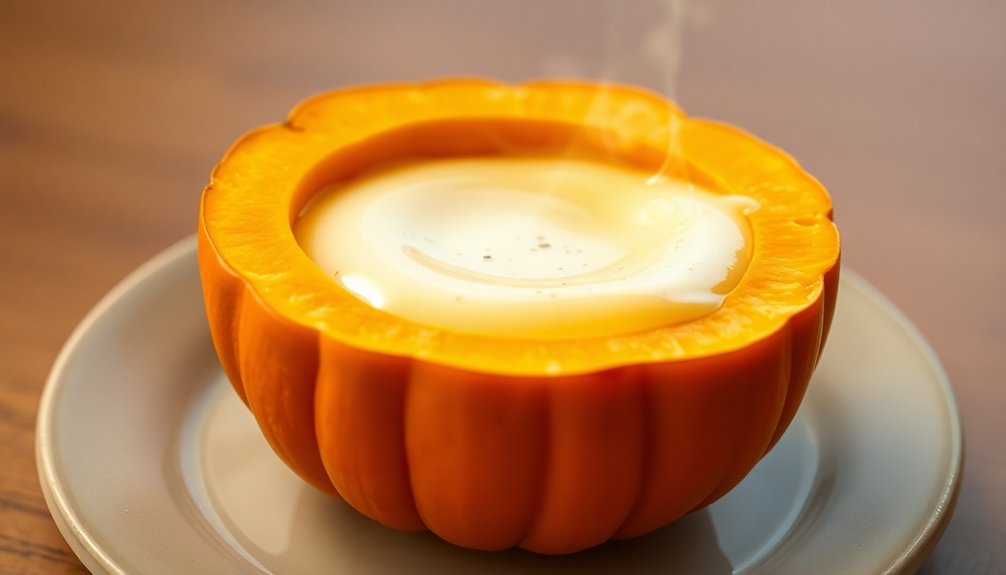Sangkaya Fak Thong - Coconut Custard in Pumpkin
You'll discover a cherished Thai dessert that emerged during the Ayutthaya period (1351-1767) when Portuguese custard techniques met local ingredients. Sangkaya fak thong combines a small kabocha pumpkin filled with silky coconut custard, steamed until perfectly set. This fusion dish, often served at Buddhist merit-making ceremonies, blends palm sugar, eggs, and coconut milk into a creamy filling. The technique and cultural significance behind this dessert reveal centuries of culinary evolution.
Key Takeaways
- Sangkaya Fak Thong is a traditional Thai dessert combining coconut custard steamed inside a small pumpkin, typically kabocha.
- The dessert originated during Thailand's Ayutthaya period (1351-1767), blending European custard techniques with local coconut milk.
- Main ingredients include coconut milk, eggs, palm sugar, and salt, steamed inside a hollowed pumpkin for 45-60 minutes.
- The custard should be strained for smoothness and steamed at medium heat until set, creating a silky, firm texture.
- Served at room temperature in wedges, displaying layers of golden pumpkin and creamy custard for a sweet-savory flavor combination.
History

Although the exact origins remain unclear, sangkaya fak thong emerged during Thailand's Ayutthaya period (1351-1767) when Portuguese traders introduced custard-based desserts to the Siamese royal court.
Local cooks adapted European custard techniques using indigenous ingredients like coconut milk and pumpkin, creating this uniquely Thai dessert.
You'll find that sangkaya fak thong has become deeply woven into Thai dessert culture over the centuries. The dish perfectly exemplifies the fusion of foreign and local culinary traditions that characterize many Thai desserts.
Its cultural significance extends beyond mere sustenance - it's often prepared for special occasions and merit-making ceremonies at Buddhist temples.
The dessert's evolution reflects Thailand's ability to incorporate foreign influences while maintaining its distinctive culinary identity.
Recipe

Ingredients:
- 1 small pumpkin (kabocha squash)
- 3 eggs
- 200ml coconut milk
- 100g palm sugar
- 1/4 tsp salt
- 3 pandan leaves (optional)
Instructions:
- Cut the top off the pumpkin and remove seeds and pulp, creating a hollow cavity.
- Mix eggs, coconut milk, palm sugar, and salt in a bowl until sugar dissolves completely.
- Strain the mixture through a fine sieve to remove any egg strands.
- Pour the strained custard mixture into the hollowed pumpkin.
- Add pandan leaves to the mixture if using.
- Place pumpkin in a steamer with boiling water.
- Steam for 45-60 minutes, or until custard is set (test with a toothpick).
- Remove from heat and let cool slightly.
- Cut into wedges to serve.
Cooking temperature: Medium heat for steaming
Servings: 4-6 people
Cooking time: 45-60 minutes
Cooking Steps

You'll begin by selecting a small kabocha pumpkin, thoroughly cleaning it, and hollowing out its interior to create a natural vessel for the custard.
Next, you'll combine coconut milk, palm sugar, and eggs into a smooth custard mixture, ensuring all ingredients are properly emulsified before carefully pouring the mixture into your prepared pumpkin.
Finally, you'll steam the filled pumpkin until the custard sets completely, then allow it to cool before slicing it into traditional wedge servings, revealing the classic Thai dessert's signature golden-hued filling nestled within the tender pumpkin flesh.
Step 1. Select Small Kabocha Pumpkin
The first critical step in making authentic Sangkaya Fak Thong is selecting a small kabocha pumpkin, ideally weighing between 1.5 to 2 pounds. This traditional Thai dessert relies specifically on kabocha, known for its sweet flavor and creamy texture when cooked.
While other pumpkin varieties might work, they won't deliver the authentic taste that's been cherished in Thai cuisine for generations.
You'll want to choose a kabocha that's dark green, firm, and free from soft spots or blemishes. The pumpkin should feel heavy for its size, indicating it's fresh and full of moisture.
This seasonal recipe typically works best with pumpkins harvested in late fall, though you can find kabocha year-round in Asian markets and specialty grocers.
Step 2. Clean and Hollow Pumpkin
Start by thoroughly washing the kabocha's exterior with cool water and a vegetable brush to remove any dirt or debris.
Then carefully slice off the top third of the pumpkin to create a lid. Using a large metal spoon or specialized pumpkin scoop, remove all seeds and stringy pulp from the interior cavity.
Be certain to scrape the inner walls clean while maintaining the pumpkin's structural integrity.
This traditional Thai pumpkin preparation technique dates back generations, when cooks would hollow gourds for various steamed desserts.
You'll want to create a smooth inner surface that'll help the custard set evenly. Leave about 1-inch thickness of pumpkin flesh around the walls - this guarantees the kabocha maintains its shape during steaming while providing enough substance to eat alongside the custard.
Step 3. Mix Custard Ingredients Thoroughly
Whisk together coconut milk, palm sugar, duck eggs, and a pinch of salt in a large mixing bowl until reaching a silky-smooth consistency.
This traditional Thai custard mixture requires thorough blending to guarantee proper custard texture when steamed. You'll want to strain the mixture through a fine-mesh sieve to remove any egg chalaza or undissolved sugar particles.
For authentic flavor balance, use premium coconut milk with at least 70% coconut extract and palm sugar from Thai palm trees.
Duck eggs, historically preferred in Southeast Asian custards, provide richer yellowing and firmer setting properties than chicken eggs.
If you notice any separation in your mixture, simply whisk again until the ingredients are fully incorporated.
The final consistency should resemble heavy cream before you pour it into the hollowed pumpkin.
Step 4. Steam Custard-Filled Pumpkin
Steaming your custard-filled kabocha requires precise temperature control and timing to achieve the silky-smooth Thai dessert.
You'll need to maintain medium-low heat and steam for 30-35 minutes, checking occasionally to verify consistent water levels in your steamer.
While kabocha is traditional, you can use other pumpkin varieties like sugar pumpkin or butternut squash - though these may affect steaming times and texture.
The custard, known as sangkaya, should set with a gentle wobble when you lightly shake the pumpkin. You'll know it's done when a knife inserted into the custard comes out clean.
Different custard flavors, from classic pandan to modern variations with coffee or taro, require careful attention to steaming times.
Let the pumpkin rest for 10 minutes after steaming before serving.
Step 5. Let Cool Before Slicing
After your steamed pumpkin emerges from the pot, you'll need to let it cool for at least 15-20 minutes before attempting to slice it. The cooling process is essential as it allows the custard to set properly and prevents the filling from spilling when cut.
This traditional Thai dessert demands patience during this step to achieve the perfect consistency.
For the slicing technique, you'll want to use a sharp knife and cut the pumpkin into wedges, similar to how you'd slice a pie. Start from the center and work your way outward, making clean, decisive cuts.
If you've followed the cooling time correctly, you'll notice the custard has become firm enough to hold its shape while the pumpkin flesh remains tender. Each slice should showcase distinct layers of golden custard and bright orange pumpkin.
Cooking Tips

To achieve the creamy texture traditional to sangkaya fak thong, you'll need to maintain precise temperature control during the steaming process.
Keep the water at a gentle simmer, never allowing it to reach a rolling boil, which can cause the custard to become grainy.
When selecting your pumpkin, choose a kabocha variety for authentic results, though butternut squash can work as a substitute.
You'll want to strain your coconut milk twice to remove any fibrous pieces that could affect the custard's smoothness.
If you can't find pandan leaves, you can substitute vanilla extract, though it'll alter the traditional flavor profile.
Watch for condensation drips from the steamer lid - they can create dimples in your custard's surface.
Test doneness by inserting a knife into the custard; it should come out clean.
Final Thoughts

Whether you're exploring Thai desserts for the first time or you're a seasoned home cook, sangkaya fak thong stands as a tribute to Thailand's ingenious fusion of local ingredients with Chinese culinary influences.
This dessert's cultural significance extends beyond its delicious taste, representing the harmonious blend of Southeast Asian and Chinese cooking traditions that have shaped Thai cuisine over centuries.
For the best serving suggestions, you'll want to present this dessert at room temperature, cut into wedges that showcase both the golden pumpkin and the creamy custard layers.
You can serve it as a standalone dessert or pair it with Thai iced tea for an authentic experience.
Don't discard the pumpkin shell - it's edible and adds a wonderful textural element to each bite.
Frequently Asked Questions
How Long Can Sangkaya Fak Thong Be Stored in the Refrigerator?
You'll find storage tips recommend consuming this Thai custard within 3-4 days under refrigeration duration. Keep it covered to prevent absorbing other food odors and maintain freshness.
Can I Substitute Pandan Leaves With Pandan Extract?
You can use pandan extract instead of fresh leaves, but you'll need to adjust the flavor intensity since the extract is more concentrated. Start with 1/4 teaspoon and adjust to taste.
Why Does My Coconut Custard Sometimes Become Watery After Cooking?
Your coconut custard's watery texture likely stems from incorrect cooking temperature or ingredient ratios. You'll need steady, low heat and a proper 1:1 ratio of coconut milk to eggs.
Is It Possible to Make This Dessert Without Steaming?
You'll be thrilled to know there are baking alternatives! While traditional steaming's best, you can absolutely bake your custard at 350°F (175°C), though you'll need to watch moisture levels carefully.
Can I Use Kabocha Squash Instead of Regular Pumpkin?
You'll find kabocha's benefits include denser flesh and sweeter taste compared to regular pumpkin. Its nutty flavor profile and starchy texture actually make it a preferred choice in many Asian custard recipes.
